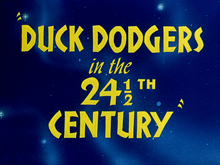Duck Dodgers in the 24½th Century
Duck Dodgers in the 241/2th Century (spoken as "twenty-fourth-and-a-half") is a 1953 Warner Bros. Merrie Melodies cartoon directed by Chuck Jones.[1] The cartoon was released on July 25, 1953, and stars Daffy Duck as space hero Duck Dodgers, Porky Pig as his assistant, and Marvin the Martian as his opponent.[2] This cartoon marked the first of many appearances of the Duck Dodgers character.
| Duck Dodgers in the 241/2th Century | |
|---|---|
 Title card | |
| Directed by | Charles M. Jones |
| Produced by | Edward Selzer (uncredited) |
| Story by | Michael Maltese |
| Starring | Mel Blanc |
| Music by | Carl Stalling |
| Animation by | (effects animator) |
| Layouts by | Maurice Noble |
| Backgrounds by | Philip DeGuard |
| Color process | Technicolor |
Production company | |
| Distributed by |
|
Release date |
|
Running time | 7:03 |
| Language | English |
Marvin the Martian had been introduced as an unnamed villain in Warner's cartoon Haredevil Hare (1948), playing opposite Bugs Bunny. He was later given the title 'Commander, Flying Saucer X-2' in 1951's The Hasty Hare. The Duck Dodgers cartoon is an extended parody of the pulp magazine, newspaper comic strip, and comic book character Buck Rogers, and his longtime run of space adventures, Buck Rogers in the 25th Century.
In 1994, Duck Dodgers was voted #4 of the 50 Greatest Cartoons of all time by members of the animation field.[3] Because he was such a fan of the short in particular, Star Wars creator George Lucas requested that the short be shown before the original Star Wars film during its initial run in theaters. In 2004 at the 62nd World Science Fiction Convention, it was retrospectively nominated for a Retro Hugo Award for Best Dramatic Presentation—Short Form.
Plot
The story begins with Duck Dodgers (Daffy) being tasked with locating the uncharted "Planet X", the only known remaining source for the rare element Eludium Phosdex, "the shaving cream atom". After a few small mishaps, Dodgers and his assistant, the "Eager Young Space Cadet" (Porky) set off by rocket. Once in flight, Dodgers plots an enormously complicated and inefficient course to Planet X, whereas the Cadet suggests a much simpler route, following a path of nearby planets bearing the letters of the alphabet (in order from A onward). After scoffing at the idea, Dodgers suddenly comes up with the same idea and takes credit for it. The ship then flies past various lettered planets and eventually arrives on Planet X.
Dodgers immediately claims the planet in the name of the Earth, but is quickly greeted by Marvin the Martian, who claims it in the name of Mars. The two engage in a battle of wits (or lack thereof), with Dodgers getting shot multiple times in the face and disintegrated (and reintegrated) once. This battle continues through most of the film, until finally Dodgers deploys his "secret weapon" - a set of explosives that surround Marvin's ship. Marvin deploys the same type of weapon against Dodgers's ship.
When the two simultaneously detonate their weapons, the planet is completely destroyed, save for one small chunk. Dodgers pushes Marvin off this chunk and once again claims it in his own name. Seen hanging from a root below him are the Cadet and Marvin. The film closes with the Cadet saying "Big deal."
Cast
- Mel Blanc as Daffy Duck (as Duck Dodgers), Porky Pig, Marvin The Martian and Dr. I.Q.Hi
Credits
The cartoon was directed by Chuck Jones (credited as Charles M. Jones), with the story by Michael Maltese, voices by Mel Blanc, and original music by Carl Stalling. The animation was credited to Lloyd Vaughan, Ken Harris and Ben Washam, with Harry Love receiving a credit for effects animation. The distinctive layouts were designed by Maurice Noble and the backgrounds produced by Phil DeGuard.[4]
Uncredited are Stalling's quotations of "Powerhouse" and "Egyptian Barn Dance" (in the opening credits), by Raymond Scott.
Sequels
- Duck Dodgers and the Return of the 24½th Century (1980)
- Tiny Toon Adventures: "Duck Dodgers Jr.", segment in the episode "The Return of the Acme Acres Zone" (1990)
- Marvin the Martian in the Third Dimension (1996), a 3-D cartoon
- Superior Duck (1996)
- Attack of the Drones (2003)
- Duck Dodgers (2003–2005), television series on Cartoon Network
Availability
This cartoon is available on Disc 2 of Volume 1 of the Looney Tunes Golden Collection and on Disc 2 of the Looney Tunes Platinum Collection: Volume 1 Blu-ray box set, with the cartoon restored in high definition, as well as Disc 1 of The Essential Daffy Duck.
See also
- Buck Rogers in the 25th Century
- List of cartoons featuring Daffy Duck
- List of Marvin the Martian cartoons
- List of cartoons featuring Porky Pig
References
- Lenburg, Jeff (1999). The Encyclopedia of Animated Cartoons. Checkmark Books. p. 103. ISBN 0-8160-3831-7. Retrieved June 6, 2020.
- Beck, Jerry; Friedwald, Will (1989). Looney Tunes and Merrie Melodies: A Complete Illustrated Guide to the Warner Bros. Cartoons. Henry Holt and Co. p. 251. ISBN 0-8050-0894-2.
- Beck, Jerry (1994). The 50 Greatest Cartoons: As Selected by 1,000 Animation Professionals. Turner Publishing. ISBN 978-1878685490.
- Duck Dodgers In The 24½th Century at The Big Cartoon DataBase bcdb.com May 9, 2011
External links
| Wikiquote has quotations related to: Duck Dodgers in the 24½th Century |
- Duck Dodgers in the 24½th Century on IMDb
- Duck Dodgers in the 241⁄2th Century at Don Markstein's Toonopedia. Archived from the original on May 5, 2016.